The Winning Goal
The Red Card
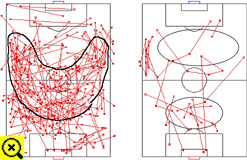
Brazil's Completed Passes
(Before the Red Card) |
Brazil's Completed Passes
(After the Red Card) |
| Ghana |
Ghana |
|
| Brazil |
Brazil |
The red card had a definite impact on the game. Up until it happened - in the 71st minute - we can see that Brazil patiently began their attacks in their own half and then switched to either flank to try and penetrate the Ghanaian defense.
After the red card, Brazil moved into Ghana's penalty area just twice during the last 20 minutes (of course scoring the winner). The team worked hard to keep Ghana at bay and most of the side's completed passes were on defense.
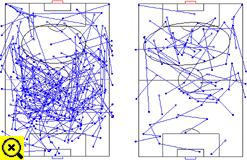
Ghana's Completed Passes
(Before the Red Card) |
Ghana's Completed Passes
(After the Red Card) |
| Brazil |
Brazil |
|
| Ghana |
Ghana |
From Ghana's perspective we can see that before the red card, they attacked mostly from the flanks but did not penetrate through the center (see circle). Basically Ghana were frustrated in their efforts to get near the Brazilian penalty area.
In fact most of Ghana's threats on the Brazilian goal came from hopeful, long range shots in the 20-30 meter range. Even after Pinto's expulsion you can see that although Ghana did apply more pressure and move forward into the completed passes zone they did not unduly worry Brazil.
The Players
And what of the individual players. We decided to compare the performances of Ghana's #9 Adjogu and Brazil's #10 Ronaldo. The SecondLook data shows that the two players had very similar games - with one difference ... but we will get to that later!
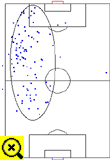
| Adjogu #9 - Player Range |
Let's initially examine the diagrams that pick apart Adjogu's contribution.
First of all when you look at the player's range it is obvious to see Adjogu loves life on the left wing. He had possession mostly on the left side of the field, from mid field to the Brazilian penalty area.
|
| Brazil |
|
| Ghana |
Look at the following 4 diagrams:
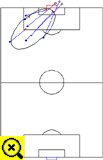
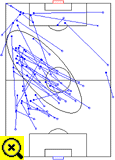 Completed Passes
Completed Passes 
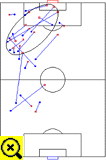
| Shots on Goal |
|
Completed Pass Receptions |
| Brazil |
Brazil |
|
|
| Ghana |
Ghana |
| His shots were from the left hand side. Most of then were from long distance and went wide. |
You see Adjogu received most of his passes from 30-35 meters from around the center circle and his main supplier was #3 Razak who completed 13 passes to Adjogu. |
| |
|
Lost Passes |
| Brazil |
Brazil |
|
|
| Ghana |
Ghana |
| Highlights Adjogu's successful passes and tell us what we already know. He likes to play on the left and he shoots when he gets to about 25 meters out. Not only does he like to receive passes from Razak he passes a lot back to him! |
Show a log of incomplete passes. He had his share of misfires outside the area but in the penalty area he had no success at all. He attempted 7 passes into the penalty area but did not complete one. In total he had a 60% completion rate. |
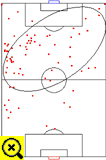
| Ronaldo #10 - Player Range |
Taking a more indepth look at Ronaldo we see that he too favored the left but was prepared to move around a little. He spent 90 per cent of the game in midfield. |
| Ghana |
|
| Brazil |

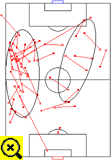
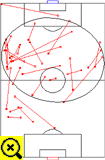

| Shots on Goal |
Completed Pass Receptions |
| Ghana |
Ghana |
|
|
| Brazil |
Brazil |
| Ronaldo took six shots during the game but like Adjoju most were from outside the penalty area and were saved by the goalkeeper or struck defenders. |
| |
| Completed Passes |
Lost Passes |
| Ghana |
Ghana |
|
|
| Brazil |
Brazil |
| Ronaldo's pass completion rate was a meager 50%, meaning he succeeded with half the 56 passes he tried. But one of the 28 that found a fellow Brazilian was very important because it set up the winning goal. |

The Winning Goal
| Ghana |

|
| Brazil |
As our diagram shows, the build-up started with a throw-in by Jorginho to Geovanni who deflected it back to Jorginho, who passed it backward to Matuzalem. The ball moved forward from Matuzalem to Abel and then to Ronaldo who passed the ball into the penalty box to Andrey, who hit home the winner.
How the game can turn. Brazil, a team that was down to 10 men and defending, countered quickly and scored the winner. Also the final pass was made by a player who had only a 50% completion rate... a rate that was lower than his counterpart on the Ghanaian team.
Ghana's Teenagers Meet Their Match
Africa's run of success in the FIFA Under-17 World Championship has come to an end. After Ghana in 1991, Nigeria in 1993 and Ghana again in 1995, the teenage World Champions at Egypt 97 came from Brazil, giving South America its first taste of success in this competition.
Before his team met Brazil in the final of the FIFA/JVC Cup in Cairo, Ghana coach Emanuel Kwasi Afranie said his boys were about to make football history. "We want to win this trophy for the third time," he said. "We want to take it home and keep it, showing that we are the best under-17 football country in the world." The ambition was healthy and entirely justifiable. Ghana were in their fourth successive World Under-17 Final, an extraordinary record unequalled in any FIFA competition. But this time they were up against especially tough and motivated opposition.
By the time the lights went out in the Cairo National Stadium on the evening of 21 September and the 35,000 spectators were on their way home through the impenetrable Cairo traffic, the talk was of the way that Brazil had clawed their way back into a game that had looked lost, and the drama of a winning goal three minutes from time. They had been treated to teenage football at its best, crowning a full fortnight of goals and excitement.
Your comments regarding this service are welcome. E-mail:

1 title won by a CONMEBOL team, Brazil in 1997. CONMBEOL is the fourth Confederation to win the title after CAF (4 wins with 2 teams), AFC and UEFA (1 win each).
1 edition without an African team present in the final match. Only in Scotland (1989), did the Africans not qualify for the Championship game. In that edition, they even failed to reach the semifinals: Guinea and Ghana were eliminated in the first round, Nigeria in the quarter finals.
1 team did not score any goal in Egypt '97 final phase; New Zealand. Making their first appearance, New Zealand not only failed to score but even to get at least a goalless draw in the 3 matches played, conceding 22 goals. Thailand, Costa Rica and Austria also lost all matches played (3) but all managed to score at least 1 goal (Thailand 4). All these teams join Canada at the bottom of the all-time ranking with 0 points earned. Canada lost all their 12 matches played, scoring 3 goals and conceding 42.
2 U-17 World Championship final matches were officiated by a Scandinavian referee. The Norwegian Hague, who directed Brazil-Ghana in Egypt '97, followed in the foot steps of Swedish Sundell, referee of Ghana-Spain 1-0 in Italy '91. A third UEFA referee was appointed to whistle in a final match: Ulsterman Irvine directed Ghana-Brazil 3-2 in Ecuador '95.
3 teams participated for their first time to the final phase of U-17 WC: Mali, New Zealand and Thailand. The total number of teams who have participated at least once is now 43. USA is the only team who has participated in all 7 editions. Australia, who previously shared this record, failed to qualify for Egypt '97 allowing New Zealand to make their début.
3 head-to-heads played between Ghana and Brazil in U-17 WC. Despite their last defeat, Ghana still leads the score 2-1, having won twice in a row (2-1 in Italy '91 quarter finals and 3-2 in Ecuador '95 final). The balance of goals scored sees Ghana leading 6-5.
4 finals played in a row by Ghana. The African team won in 1991 (1-0 against Spain) and 1995 (3-2 against Brazil) and lost in 1993 (1-2 against Nigeria) and 1997 (1-2 against Brazil).
13 goals scored in the 1st round match between Spain and New Zealand, a record for the U-17 World Championship. Also the previous record (9 goals) was held jointly by Spain: on 20th August 1991 in Livorno the Spanish team defeated Cuba 7-2. Ismailiya's match was also the match with the highest goal difference (prev. NGR-CAN 8-0, Japan '93) and, obviously, the first with 10 or more goals scored.
15 referees directed the 32 matches of Egypt '97 edition. Four officiated in 3 matches each: McLeod (RSA), Rodriguez Portillo (SLV), Granat (POL) and Sanchez Yanten (CHI). Only 2 directed just 1 match each: Al Dokhail (KSA) and Brazzale (AUS).
19 matches won by Brazil and Ghana in final phases. Both teams are at the top of the all-time ranking but Ghana has a better percentage (70.37 to 65.51) due to fewer number of matches played.
29 matches played by Brazil in their 6 appearances in the final phase. Brazil lead the all-time ranking, followed by Ghana (27), Nigeria and Argentina (26 each).
41 goals scored by the Brazilian team in their road to the U-17 World title. Brazil played a total of 13 matches: 7 in preliminary competition (5 wins and 2 draws; 20 goals scored, 7 conceded) 6 in final phase (all won: 21 goals scored, 2 conceded).
115 points earned by CONMEBOL and UEFA teams in the 7 editions of U-17 World Championship. South America (CONMEBOL) equalised Europe (UEFA) thanks to the 6-point margin they received in Egypt (29-23). The African region (CAF) still leads the all-time ranking with 138 points, while Asia (AFC) is 4th (76), North/Central America and Caribbean region (CONCACAF) is 5th (37) and Oceania (OFC) 6th (23).
Facts & Figures compiled by:
A P P E N D I X
Figure 1
return to article



Figure 2
return to article
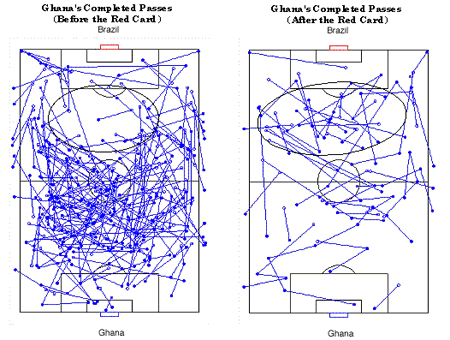


Figure 3
return to Adjogu
return to Ronaldo



Figure 4
return to article
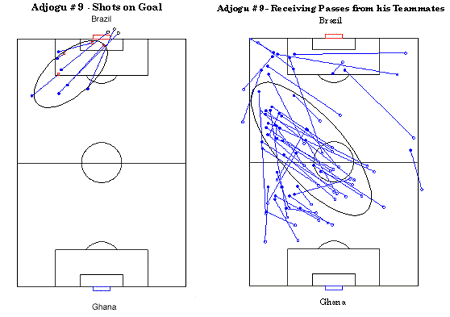


Figure 5 return to article
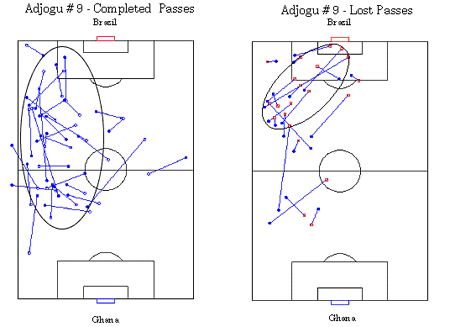


Figure 6
return to article



Figure 7
return to article
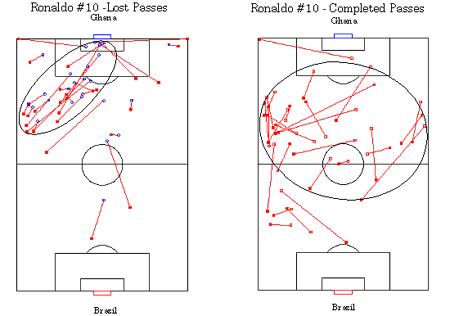


Figure 8
return to article
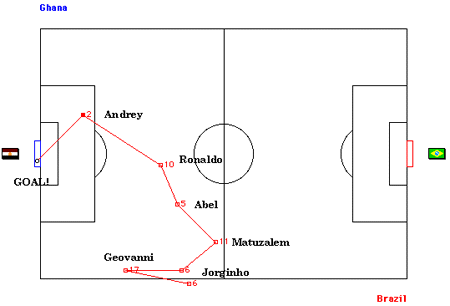


Copyright © 1994-97 FIFA. All rights reserved.
Copyright © 1997 En-Linea, Inc. All rights reserved.








 Completed Passes
Completed Passes 


















